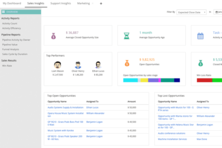Open-source CRM software allows organizations to modify CRM software solutions according to their standards, giving them greater control. This is especially helpful in setting requirements for their operating systems. Since each industry offers different services, it’s expected that some require different features. With open-source programs, you get to make major or minimal changes to software solutions. As such, you’re essentially given a program that can be specifically tailored towards your needs.
Since CRM focuses largely on customer relationships and interactions, having the right controls for each step can relatively improve the flow of business. Customization is the keyword in open-source software. You can customize the existing organizational requirements to address the needs of your business. This is done by editing the source code. You no longer have to pay for additional features from software vendors just to get the job done.
The opposite of open-source CRM is proprietary CRM, which refers to a system in which the vendor has complete control over the available features. Differences between the two include the features, customizations, updates, support, costs and third-party integrations. While open-source CRM does give you the freedom to change and add certain core features into your system, it comes with added responsibilities as well. You also become in charge of updating and maintaining your CRM system, which is the sole job of the vendor in proprietary CRM software.
However, the ability to completely control your software is the main reason why companies and enterprises chose to adopt open-source systems in the first place. Everything—from its features down to the third-party integrations—is handled by their own hands. They no longer have to unnecessarily wait for updates or new versions of the software from the vendors. Instead, as the business grows and new features need to be implemented, they’re the ones developing their own updates.
Before you decide on which open-source CRM program to adopt, you need to try to compare the existing ones in the market. Most of them offer feature-rich systems capable of several functionalities. However, it’s best to find one that perfectly fits the needs of your business. As such, the main criteria you can use to decide on your CRM application include license and support costs, contact management, deal and opportunity management, workflow automation, reporting tools, user interface and experience, ease of implementation, training and documentation, as well as customer satisfaction.
Examples of open-source CRM programs are Vtiger CRM, X2CRM, OroCRM and many more.

 Vtiger is a free open-source CRM solution that offers hundreds of professionally developed plugins through its extension marketplace.
Vtiger is a free open-source CRM solution that offers hundreds of professionally developed plugins through its extension marketplace.
Businesses and companies use open-source CRM software like any other software solution. The only difference between open source and proprietary is that owners are capable of customizing and modifying the source code. What this entails is you’ll get to decide which CRM tools are most valued based on your business’ performance. Depending on the flow of your company, you get to decide which features to implement and how they work specifically in your system.
Vtiger CRM is an Indian-based open-source CRM software solution—perfect for companies in need of powerful, browser-based and cloud-hosted systems. Its integrated features are tailored to help the sales, marketing and support teams in daily tasks. Moreover, it offers assistance primarily in organization and collaboration.
Due to the ability to customize functionalities in the source code, you can choose which ones are best suited for your organization. This allows you to deliver high-quality services to your clients. It should be noted that the most sought-out features in open-source CRM software solutions consist of the following:
Managing contacts is one of the main features of CRM solutions. Without a centralized location to hold a customer database, it becomes difficult to actively interact and engage with them. In order to retain customer loyalty, you need to ensure their information is well protected and valued by the company.
This feature allows you to determine which leads should be pursued. In customer-oriented businesses, lead management is a valuable functionality to have as it saves you time and energy from pursuing dead-end leads. It does this through a number of ways, such as letting you know the right time to focus on the right leads based on demographics.
This feature refers to the ability to check your interface from any mobile device. It’s particularly helpful for updates and notifications, especially when the sales team is on the move. You’ll never miss any important information regarding your customers.
Having a cloud-based software solution means you’re able to upload valuable database online without fear of losing it due to corrupted hardware. Furthermore, having online access allows the entire team to view the same details and information, regardless of their department. This ensures accuracy and reliability from the viewpoint of each employee.
The last noteworthy feature to discuss is reporting and analytics. With this tool, you can view the current trends in the market and analyze the performance of your business. This is helpful in terms of gaining insights and perspective about what your customers want. Also, you can make informed decisions on relevant matters based on generated reports and statistics.
When discussing the benefits of open-source CRM software, it is often best to first discuss what is lacking in proprietary CRM. Open source is a solution to all the issues found in vendor-dependent solutions. Instead of relying heavily on updates and maintenance, you can now develop them on your own as time passes on. Additionally, you get to freely customize and creatively innovate your application to your heart’s content.
One of the benefits you can receive from an open-source CRM application is the ability to customize. Every business has different objectives and goals in their organization. Some want to fully integrate their style into their interface while others want better customer service features. It doesn’t matter—you get to decide which features to highlight and how to improve your overall business platform.
Another benefit you can enjoy is full independence from software providers. You no longer have to buy an entire suite just to access a single, critical feature. Instead, users are free from lock-in and unnecessary vendor restrictions, contracts and requirements.
Open-source CRM software makes it easier to be able to address rising problems as soon as they come up. Because you’re in charge of how you modified the source code, only you are able to fix it effectively. This lessens your dependence on outside sources, which means the problem can be fixed without any additional costs.
This is the main reason why people opt for open-source CRM software. It’s cost-effective and budget-friendly. The source code is free and can be modified accordingly.
Even though it’s last on the list, improved customer relationships are what you need to increase the flow of business. With specific tools tailored to enhance user experience in navigating your interface, you’ll find an influx of customers coming back for more. It’s highly important to address their needs as soon as they come up. You can’t do that with general software solutions—you need one that’s suitable to meet your objectives.
Overall, open-source CRM software is a valuable asset to apply in your operating systems. Since it’s been customized to fit the business’ needs, you can expect an increase in workflow and streamlined processes. Your relationships with your customers improve as well due to having immediate features catered to dealing with their interactions. When you respond immediately to their queries and concerns, you enhance their user experience. With better experiences comes satisfactory customer service.